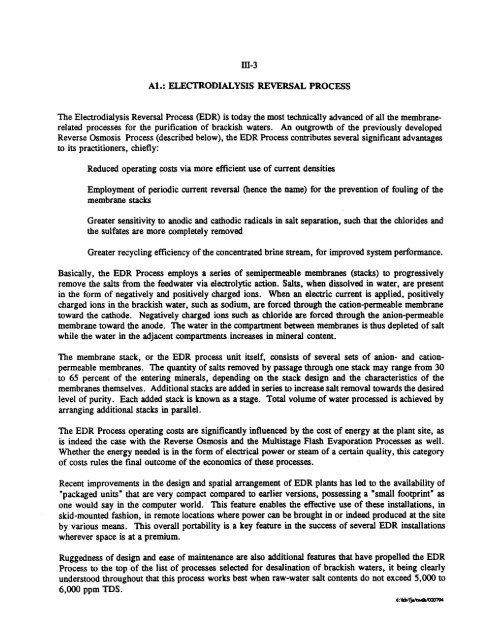(GP/GT) for Additional Water Supply in the Lower Rio Grande
(GP/GT) for Additional Water Supply in the Lower Rio Grande
(GP/GT) for Additional Water Supply in the Lower Rio Grande
Create successful ePaper yourself
Turn your PDF publications into a flip-book with our unique Google optimized e-Paper software.
ill-3<br />
At.: ELECTRODIALYSIS REVERSAL PROCESS<br />
The Electrodialysis Reversal Process (EDR) is today <strong>the</strong> most technically advanced of all <strong>the</strong> membranerelated<br />
processes <strong>for</strong> <strong>the</strong> purification of brackish waters. An outgrowth of <strong>the</strong> previously developed<br />
Reverse Osmosis Process (described below), <strong>the</strong> EDR Process contributes several significant advantages<br />
to its practitioners, chiefly:<br />
Reduced operat<strong>in</strong>g costs via more efficient use of current densities<br />
Employment of periodic current reversal (hence <strong>the</strong> name) <strong>for</strong> <strong>the</strong> prevention of foul<strong>in</strong>g of <strong>the</strong><br />
membrane stacks<br />
Greater sensitivity to anodic and cathodic radicals <strong>in</strong> salt separation, such that <strong>the</strong> chlorides and<br />
<strong>the</strong> sulfates are more completely removed<br />
Greater recycl<strong>in</strong>g efficiency of <strong>the</strong> concentrated br<strong>in</strong>e stream, <strong>for</strong> improved system per<strong>for</strong>mance.<br />
Basically, <strong>the</strong> EDR Process employs a series of semipermeable membranes (stacks) to progressively<br />
remove <strong>the</strong> salts from <strong>the</strong> feed water via electrolytic action. Salts, when dissolved <strong>in</strong> water, are present<br />
<strong>in</strong> <strong>the</strong> <strong>for</strong>m of negatively and positively charged ions. When an electric current is applied, positively<br />
charged ions <strong>in</strong> <strong>the</strong> brackish water, such as sodium, are <strong>for</strong>ced through <strong>the</strong> cation-permeable membrane<br />
toward <strong>the</strong> cathode. Negatively charged ions such as chloride are <strong>for</strong>ced through <strong>the</strong> anion-permeable<br />
membrane toward <strong>the</strong> anode. The water <strong>in</strong> <strong>the</strong> compartment between membranes is thus depleted of salt<br />
while <strong>the</strong> water <strong>in</strong> <strong>the</strong> adjacent compartments <strong>in</strong>creases <strong>in</strong> m<strong>in</strong>eral content.<br />
The membrane stack, or <strong>the</strong> EDR process unit itself, consists of several sets of anion- and cationpermeable<br />
membranes. The quantity of salts removed by passage through one stack may range from 30<br />
to 65 percent of <strong>the</strong> enter<strong>in</strong>g m<strong>in</strong>erals, depend<strong>in</strong>g on <strong>the</strong> stack design and <strong>the</strong> characteristics of <strong>the</strong><br />
membranes <strong>the</strong>mselves. <strong>Additional</strong> stacks are added <strong>in</strong> series to <strong>in</strong>crease salt removal towards <strong>the</strong> desired<br />
level of purity. Each added stack is known as a stage. Total volume of water processed is achieved by<br />
arrang<strong>in</strong>g additional stacks <strong>in</strong> parallel.<br />
The EDR Process operat<strong>in</strong>g costs are significantly <strong>in</strong>fluenced by <strong>the</strong> cost of energy at <strong>the</strong> plant site, as<br />
is <strong>in</strong>deed <strong>the</strong> case with <strong>the</strong> Reverse Osmosis and <strong>the</strong> Multistage Flash Evaporation Processes as well.<br />
Whe<strong>the</strong>r <strong>the</strong> energy needed is <strong>in</strong> <strong>the</strong> <strong>for</strong>m of electrical power or steam of a certa<strong>in</strong> quality, this category<br />
of costs rules <strong>the</strong> fmal outcome of <strong>the</strong> economics of <strong>the</strong>se processes.<br />
Recent improvements <strong>in</strong> <strong>the</strong> design and spatial arrangement of EDR plants has led to <strong>the</strong> availability of<br />
"packaged units" that are very compact compared to earlier versions, possess<strong>in</strong>g a "small footpr<strong>in</strong>t" as<br />
one would say <strong>in</strong> <strong>the</strong> computer world. This feature enables <strong>the</strong> effective use of <strong>the</strong>se <strong>in</strong>stallations, <strong>in</strong><br />
skid-mounted fashion, <strong>in</strong> remote locations where power can be brought <strong>in</strong> or <strong>in</strong>deed produced at <strong>the</strong> site<br />
by various means. This overall portability is a key feature <strong>in</strong> <strong>the</strong> success of several EDR <strong>in</strong>stallations<br />
wherever space is at a premium.<br />
Ruggedness of design and ease of ma<strong>in</strong>tenance are also additional features that have propelled <strong>the</strong> EDR<br />
Process to <strong>the</strong> top of <strong>the</strong> list of processes selected <strong>for</strong> desal<strong>in</strong>ation of brackish waters, it be<strong>in</strong>g clearly<br />
understood throughout that this process works best when raw-water salt contents do Dot exceed 5,000 to<br />
6,000 ppm IDS.

















